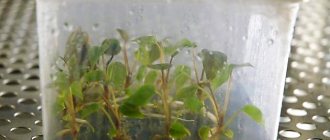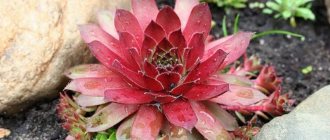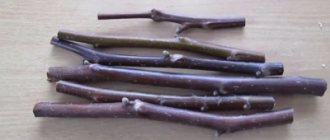How to propagate aloe at home - the best time to do it
Each plant is characterized by periods of activity and dormancy. Aloe transplantation can be done at any time of the year, but spring and June are considered the best times. During such a period, the transplanted flower will quickly get used to the new soil and new conditions and begin to grow.
In warm weather, it is convenient to maintain the required temperature for a young flower.
Aloe propagation is a simple process.
How to plant aloe babies correctly
Propagation of aloe by children is used by most gardeners, since this method is the simplest and most reliable of all known, because small plants already have their own root system. The main task of the gardener is to cut off the young plant from the roots of the mother plant so as not to damage either the adult flower or the shoots. Perhaps the safest way to do this is during transplantation, when the aloe is removed from the pot and freed from the old substrate. All roots are clearly visible, and it is easier to choose the most suitable place to make the cut.
The cuts on the roots of both the mother liquor and the children are sprinkled with crushed charcoal powder. They wait several hours until the wounds on the roots dry, then plant them in separate pots filled with an earth mixture of equal parts of leaf and turf soil and half of sand with the addition of a small amount of brick chips.
Transplanted babies are moistened with a small volume of water every 2 days. Feeding begins after young leaves appear at the top, indicating that the baby has taken root and started to grow. Fertilizers for succulents and cacti are used as fertilizers according to the manufacturer’s recommendations indicated on the packaging.
Peculiarities of reproduction depending on the type of aloe
How to propagate Ficus at home - all possible ways
Many species of aloe have been bred, but there are no specific features in their reproduction. However, there are some recommendations depending on the variety and how aloe reproduces:
- Aloe vera. It is the most popular plant. It has a short stem and long leaves. The flower practically does not bloom, so propagation by seeds is impossible. For propagation, the apical method or shoots are used.
- Aloe arborescens. It is distinguished by the presence of long and narrow leaves, which are chosen for propagation.
- Aloe variegated. The leaves have a tiger color and reach a length of 30 cm. It is better to plant such a plant with tops or children.
Interesting! Aloe blooms are rare. But sometimes it is possible to collect seeds for subsequent planting.
It is recommended to choose the most convenient and gentlest propagation method for the plant.
Container with flowers for replanting
Aloe cuttings: what part of the plant can be used?
Plant cuttings take root no worse than children. You can obtain planting material from an adult bush by cutting off:
- top (it must have at least 7 sheets);
- the so-called “branch” - that is, a lateral branch extending from the central stem.
Regardless of which part of the bush will be used, it must grow roots before planting. To do this, the cuttings are dried and placed in a container with water.
Preparing for plant propagation
Ficus Natasha - description of the flower and rules of care at home
Before planting aloe at home, it is necessary to prepare the soil and materials so that the process does not drag on for a long period.
Materials and tools
To plant young bushes, it is recommended to prepare the following:
- New container. You don’t have to take a large pot right away; a medium-sized container will be enough for a small sprout.
- A jar of water for temporary storage of babies and shoots.
- Priming. It is better to give preference to ready-made and buy it in a specialized store. As a last resort, it is permissible to make suitable soil yourself.
- A small spatula that is used to dig up young sprouts and with which they can then be planted.
- A stationery knife - it is quite acceptable to take a regular one, but very sharp. It will be needed to cut leaves and shoots.
- Preparations to stimulate growth and root formation.
Correctly and timely prepared tools will allow the planting process to be carried out faster and with better quality.
How to prepare a flower?
Preliminary preparation significantly increases the chances of a successful transplant. They work with the flower according to the following scheme:
- Water thoroughly 3-4 hours before transplanting.
- Turn the pot over and tap it with your palm on all sides. If the roots have grown too much and the flower does not want to fall out of the pot, the flowerpot will have to be broken. If you forcibly cut aloe from a planting container using a spatula, the root system will suffer irreversible damage and, most likely, the plant will die.
- Separate old adhering drainage from the bottom of the earthen clod.
- Inspect the remaining rhizome. If you find rotten or moldy roots, shake off as much soil as possible, carefully disassemble it with your hands and rinse with running water.
- Trim diseased or damaged roots with scissors. Sprinkle the cuts with charcoal.
Soil selection
The substrate for aloe should be as close as possible to the soil in its growing area. Criteria that the soil must meet:
- Breathability. The soil should be so crumbly that even after watering it is difficult to form a ball.
- Low acidity. The maximum permissible pH level is 8.0. It is desirable that the substrate be neutral.
- High iron content. This element stabilizes photosynthesis processes in succulents.
This is interesting: Why the leaves of indoor plants become sticky - reasons and control measures
You can buy soil in the store (for succulents and cacti) or prepare it yourself. To do this, turf and sand are combined in a 1:2 ratio, nutrients and vermicompost are added.
Important! The earth is pre-steamed in the oven at a temperature of +60 °C. This destroys the germs and insects in it.
Soil requirements
In natural wild conditions, aloe lives in hot and arid climates, inhabiting infertile, poor, dry clay or sandy places. Therefore, in home and apartment conditions, after propagation, the flower will feel comfortable in an environment as close to natural as possible. The composition of the soil must be selected correctly, since the full development of the plant directly depends on this.
The soil mixture for aloe, which is considered a succulent, must be loose and free-flowing, not retain moisture and allow air to pass through without problems, and also contain the required amount of ferrous substances. The desired acidity level is close to neutral (6.7-7 pH). Such soil mixtures, intended for succulent and cactus crops, can be purchased at any florist or gardening store. However, many gardeners prefer to mix the substrate when propagating aloe themselves, preparing the following components (2:1:1):
- fertile soil (garden, leaf, turf, etc.);
- sand (only coarse, necessarily sifted and washed from dust) or fine gravel;
- humus or garden compost.
Before proceeding directly to propagation, it is recommended to disinfect the soil mixture prepared for aloe:
- spilling potassium permanganate dissolved in water;
- calcined in the oven;
- keeping it at maximum heating mode in a microwave oven;
- steamed in a water bath;
- frozen (can be in the freezer).
Preparing the soil and container
For planting, it is better to choose a container made of plastic. This material does not allow moisture to pass through well; the aloe root system will like it. The size of the container should correspond to the rhizome; it should be free and have some space left. However, it is not recommended to choose a deep container; a medium size is better.
How to replant aloe at home yourself
Before rooting aloe at home, prepare the soil. If it is not possible to buy ready-made soil, then it is permissible to make suitable soil yourself. To do this, combine clay and turf in equal quantities, add sand, humus and leaf soil. It is necessary to put a drainage layer at the bottom of the pot so that there is no constant stagnation of water.
Important! Before planting aloe, it is recommended to calcinate any soil in order to destroy possible parasites and pests.
Leaves are placed in a glass of water to obtain roots.
Soil for aloe
Aloe is a guest from southern countries. There the plant is accustomed to growing in sunny conditions, on dry, clayey, sandy soils and being content with scanty rainfall. Therefore, the conditions for growing aloe at home should be as close to natural as possible.
In hot climates, even in the complete absence of water and soil, the plant not only grows, but also produces new shoots for reproduction. This plant receives the nutrients necessary for growth and development from its own leaves. Therefore, fresh aloe leaf juice is a storehouse of energy and nutrients.
The soil for aloe must be water and breathable. Therefore, washed coarse sand, gravel, brick chips or shell rock are often added the soil for planting aloe Ordinary soil from the garden is mixed with one of the listed baking powders.
Aloe will feel good on a bright and warm window facing south or east. The plant loves fresh air, so placing it under a window in a small clay or plastic pot will be comfortable for it.
Aloe propagation methods at home
There are several different methods for propagating aloe. Each of them has some features that should be taken into account.
Leaf
Propagation of an aloe flower by leaf is often used to rejuvenate an old plant. The procedure is performed in a certain sequence:
- Choose a quality leaf about 8 cm in size.
- Cut it off with a clean knife or blade near the base at an angle.
- The leaves are left in a dry cloth for a couple of days in the dark so that the cut area dries out.
- The cut is sprinkled with activated carbon.
- The selected soil is poured into the pot and watered well.
- The leaves are placed in a container, deepened by 3 cm.
- The pot is left in a warm and bright place.
Sometimes the leaves are not even buried, but simply left on the surface. The roots will go into the ground on their own. But in this case, you need to carefully monitor the humidity so that the leaves do not dry out.
The leaves are dried for a couple of days
First care
- In the first two to three weeks, you should not place a pot with a transplanted flower on a cold windowsill. It is recommended to place the plant in a well-lit, warm place. To avoid burns, avoid direct sunlight.
- Immediately after transplantation, for better rooting, the flower must be watered with a solution of phytosporin, dissolving 1 teaspoon of powder per liter of warm water.
- It is necessary to water the seedling 2-3 times a month in the warm season, and 1 time a month in winter. You should not feed aloe for the first 6 months, because the flower was planted in fresh soil.
If you follow these recommendations, you can achieve good results when propagating aloe. This flower is very easy to care for, and even a novice gardener can propagate and grow an entire plantation of these useful plants.
Cutting method
Propagating aloe vera by cuttings is a simple and therefore very popular method. If such a transplant is carried out in spring and summer, then in most cases it is possible to obtain young, strong plants very quickly. High-quality lateral shoots from the main trunk are taken as cuttings.
The procedure is carried out step by step:
- Select suitable cuttings - preferably straight ones, about 10 cm in size; there should be more than 6 leaves on the shoot.
- Treat the knife with a disinfectant solution, carefully cut the shoot at an angle, trying not to damage the leaves and other parts of the plant.
- The shoot is left in a dry and dark place for about a week so that the cut dries and becomes covered with a film. Humidity should be about 50%.
- Before planting, prepare a planting mixture and a suitable container.
- The pot is filled ¾ with soil. The cut on the cutting is treated with activated carbon and placed in the prepared soil for a couple of centimeters, and the soil is carefully added.
- If necessary, you can add pebbles on top to keep the plant tightly in the pot.
Important! The container is left in a bright and warm room, the young flower is watered according to the condition of the soil.
The roots of the plant will appear in a couple of weeks. Transplantation into another container can be done after the plant begins to appear new leaves.
Reproduction by children
Breeding aloe using seeds
Aloe propagation by seeds is rarely done. This plant blooms quite rarely, so obtaining planting material is not easy. In addition, a similar method of growing an aloe flower takes quite a long time.
The best time to plant a plant is considered to be the end of February - beginning of March.
Landing is carried out as follows:
- Prepare a flat and wide container and fill it with suitable soil.
- The soil is moistened, seeds are placed in it to a depth of about 3 cm, and sprinkled with soil.
- Cover the container with glass or polyethylene, this will allow the seeds to germinate faster.
- Until the first sprouts appear, maintain the required humidity and temperature in the pot.
- After seed germination, the shelter is removed, irrigation is carried out as needed using a spray bottle.
- When 4 leaves are formed, the young flowers can be transplanted into more suitable pots.
Further care is carried out similarly to an adult plant. After a year, the aloe is transplanted into a new pot.
Important! A full-fledged plant can be obtained only a couple of years after planting the seeds.
Rooting the top
If the plant is very old and looks unsightly, it can be rejuvenated by rooting the crown. This method is traumatic for the flower, so it is used only when the lower leaves and shoots have already been cut off. The method is simple and allows you to quickly get a new and strong plant.
Carry out the following actions:
- The top is cut off so that at least 7 leaves remain on it.
- The cut sprout is left in the root growth stimulator solution for half an hour.
- The top is then placed in a glass of warm water.
After some time, roots will appear on the shoot. When they reach a size of approximately 6 cm, the flower can be planted in a container with prepared soil.
Important! Clean tools are used to cut off the top to avoid contamination and infection of the flower.
This method of breeding is suitable even for novice flower growers, because it does not take much time and is quite easy to implement.
Growing roots
Children
This method is suitable only for those plants that have “babies”. If you want to propagate aloe using this method, then select a tight pot for the flower. This does not stimulate growth, but rather the formation of “children”. As soon as they begin to appear, they are planted by following these steps:
- The entire adult flower is removed from the pot.
- The formed “baby” is separated using a knife or blade, cutting off diagonally. In this case, the roots should remain on the “baby”. Before planting an aloe flower, prepare the soil.
- Small flowers are transplanted into specially prepared containers with soil, which is lightly pressed down to secure the plant.
- An adult aloe is returned back to the pot or transplanted into a new one.
Plants planted in this way grow and develop very quickly. The main thing is that the babies have roots present when transplanting.
Children in a pot with an adult plant
Broken plant parts
Unfortunately, there are often cases when part of the aloe was accidentally broken. In such situations, you should not be upset; these pieces can also be planted.
Depending on how the plant was broken, there are several ways to restore it:
- In case of serious damage, the leaves are cut off and planted in the manner described above.
- If the aloe roots are preserved, then it can be propagated by leaves with roots. It is recommended to immediately plant them in pots with prepared soil.
- In the absence of roots, the flower is propagated by the tips.
Important! You can try to save even severely damaged aloe. The main thing is to take all necessary measures in time.
Aloe propagation problems
When rooting cuttings, the most common problem is rotting of the base of the shoot from excessive moisture. This phenomenon is observed if the cut of the shoot is not sufficiently dry before being buried in the substrate, and the moisture content of the soil mixture turns out to be excessive. Unfortunately, a rotten cutting can no longer be used for rooting; all that remains is to throw it away, cut a new one and start all over again.
The main problem when sowing seeds is poor germination. However, it all depends on the quality of the seeds; aloe usually sprouts quickly. True, the time for germination differs in different natural species - in some, seedlings appear within a week, in others - after a month.
There is practically no hassle with the propagation of aloe with the help of children, unless the young plants are moistened too abundantly from the first days of transplantation and begin to be fed early.
Caring for the plant during the rooting period
During rooting, it is necessary to provide the flower with the necessary care. This will allow aloe to quickly adapt to new conditions and begin to develop.
It is recommended to adhere to the following rules:
- All small flowers are protected from direct sunlight, this will help avoid burns.
- During the warm period, the flower is taken out into the fresh air. First for a short time, gradually accustoming him to new conditions. When planting in summer, it is better to perform such actions a year later.
- When planting in winter and autumn, flowers are extended daylight hours with the help of lamps and lamps.
- Be sure to maintain watering, do not allow the soil to dry out, and monitor the condition of the plant. Excess moisture is also dangerous for the flower and can cause rotting of the root system.
- The room with pots is often ventilated, but make sure that the incoming air is not too cold.
- The leaves are periodically wiped to remove dust and dirt.
- After several months, the plants begin to be fertilized with special fertilizers.
Compliance with such rules will allow the plant to quickly adapt and not die.
Sprouts with roots
Features of care after reproduction
After you have planted the seedlings in separate pots and they have pleased you with their new grown leaves, you can pamper them with fertilizers. Now regular watering can be done more frequently (once a week). But do not forget about moderation of moisture to avoid rotting and death of the plant. We wrote about plant diseases in this article.
It is better to breed aloe in spring or summer, so that the flower has enough sun and warmth for complete restoration and subsequent care for winter rest.
Rarely anyone will refuse to have not just a beautiful plant on their windowsill or balcony, but an entire pharmacy for rejuvenating and healing the body. Take care of your aloe, please it with proper care and it will grow to your delight.
Propagation by seeds
This method is used quite rarely. And in practice, as a rule, only experienced gardeners use it. Aloe vera is most often propagated by seeds. Growing aloe from seeds takes a long time, but there is a certain charm in watching how a small seed develops into a full-fledged adult plant.
Ready-made aloe seeds are sold in specialized stores. It is a rare grower who manages to get seeds from his plant that has produced flowers.
Seeds are planted between late February and early March. Aloe plants are very light-loving plants, so they are specially planted when daylight hours increase. It is also important to maintain the optimal temperature for plant growth; it is 21-23 degrees.
The soil for planting seeds is chosen the same as for adult aloe. But you will have to try to keep it moist. Seeds are sown in prepared, moistened soil, after which it is recommended to cover the container with plastic film, which will create a greenhouse effect.
It will take a long time for the seeds to germinate. On average, it takes about 1.5 months. When the sprouts reach a height of 5 centimeters, they can be planted. But you will see young aloe in its usual form no earlier than in a year and a half.











